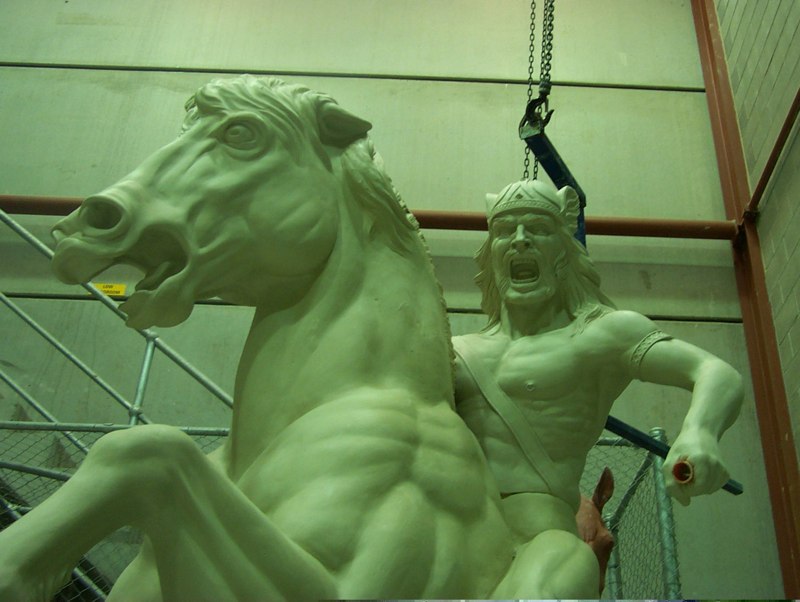
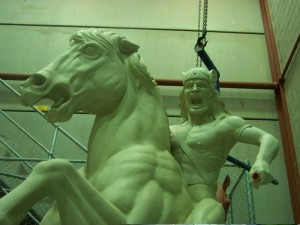 Archival interview with Belinda Villani from the official Matrix website.
Archival interview with Belinda Villani from the official Matrix website.
THE MATRIX PODS
MATRIX: How did you come to be on THE MATRIX sequels?
BELINDA: I had just come off another film – Queen of the Damned – the Set Decorator on that was Brian Dusting, and he is also on this film [as the Set Decorator]. I happened to be in here on the right day with my C.V. and was called in to work on some sculptures for the Merovingian’s Chateau set (and I also worked on the original film). There were quite a few sculptures on that set, so we had a team of about three different Sculptors all working on different sculptures on that.
MATRIX: Did you plan to get into sculpture?
BELINDA: I got into this industry purely by luck. I was a graphic design student, had finished my course and went to a company that did this sort of work and was offered a job, and that was about eighteen years ago, so that’s what I’ve been doing ever since. There was no big decision to do it; it just fell into my lap.
MATRIX: Over that time period have you always sculpted with the same materials?
BELINDA: Yes. My knowledge of different materials has improved a lot, but I have pretty well always done clay and plasticine sculptures for various makeup effects, special effects and props.
MATRIX: What projects were you involved in on THE MATRIX?
BELINDA: On the first film I worked for a company that did the silicon skins on the pods, and I made silicon skins for Neo to break through when he was getting out of the pods. We tested various different silicons to find a silicon that was nice and rubbery, that sealed up the jelly liquid that he had to be inside, yet that he could easily break out of without being in any sort of dangerous situation. So we tested them ‘til they were just thin enough that they still held their consistency on the jelly, but could be broken out of easily. There were a couple of different tests with different materials, but once we worked that out it was just a matter of mass-producing them for each take.
MATRIX: How were they tested; did you actually test them over a pod and have someone break out?
BELINDA: Yes, we had a frame and we would just push through it, and if it broke through nice and easily but didn’t break just carrying it across the room, then that was okay.
MATRIX: Do you remember how many of those skins you did on the pods?
BELINDA: I think we did about fifteen skins for that one shot of him breaking out. I remember actually being out on set on that day, it was freezing cold, it was raining, and the poor guy had to be in this big pod of goo, and he was very professional, he never complained. But it must have been revolting.
MATRIX: Was it Keanu Reeves himself?
BELINDA: Yes, he was in this pod which was like a bathtub full of slime, and he had to be totally immersed in it, and the skin had to go over and he had to break out through it. I think he was a very brave man because it was freezing.
MATRIX: How could he breathe?
BELINDA: He would go down, we’d put the skin on, and he’d come straight out. And then a lot of the shots were him sitting up already and then breaking out of it, so there were different stages. The actual breaking through was a very quick shot, and then he’s in the pod with it torn, pulling it off the rest of it, and then he gets sucked back down through the tube.
MATRIX: Did the skin have a color?
BELINDA: It just had to be clear, so we used clear silicons. The jelly inside the pod had a red tinge through it, and because the silicon was clear it took on whatever color was underneath it. I remember working on this for ages and yet it was just this one quick shot. It took us like quite a few weeks to get it right, because we had to put different quantities of silicon oils in the silicon to get them just the right consistency. We had quite a few failures before we got it down pat. It took probably about two months to get those twelve skins out. We had to get the tables level on very uneven surfaces – we all work on very uneven floors around here, so just getting a level table was half the problem – and then pouring it on the skins, and then peeling them off the tables without them tearing. They had to be fairly weak for him to break through, and if you used a release agent that could cloud the silicon and you’d ruin it, so there was quite a trick to removing them from the table.
MATRIX: Was the skin made to a particular shape on the table?
BELINDA: Yes, it was on a frame that actually clicked straight on to the top of the pod, so they were picked up and fitted straight in. I had to make some steel frames for that as well.
MATRIX: Has the mood from the first film to the sequels changed at all?
BELINDA: I didn’t work on the first film for very long , but it was all pretty exciting because it was quite a big film at the time; I think it was the second big film in Fox Studios. There have been plenty of these sorts of films now so there’s a bit of it being just another film, but it’s an exciting film. Things have changed a lot too in the last few years: more practical effects are almost left behind and visual effects are the way of everything now. I think Visual Effects is the major department in a film now, whereas it had always been minor – they did the titles at the beginning of the film – and now a good percentage of film is all coming through visual effects.
THE MEROVINGIAN CHATEAU
MATRIX: What was your first role on THE MATRIX sequels?
BELINDA: The very first thing I had to do here – which was nearly a year ago now – were some maquettes for some statues for a very large set that was full of sculptures [Merovingian Chateau], which was a dream come true for a Sculptor. We did a lot of maquettes first, and because the sculptures were quite large – they were about ten percent bigger than life size – we had to then scale them all up.
Some of the nice ones I did were two large horses made from one mold with two identical riders, but a mirror image of each other. I was given a very rough idea of what they wanted, and then it was left to me to do the maquette, and then it had to be approved.
MATRIX: Could you describe what a maquette is.
BELINDA: A maquette is a scale version of what the final product will be. We did a ten percent maquette, so a little piece ends up being quite large. That way you can establish the look, the scale and any changes, which are much easier to do at that stage, and once that has been approved by the Production Designer [Owen Paterson], we can go ahead and scale it up to do the full size. Because there were so many sculptures, that was the quickest way to do it. You don’t want to change an arm or a leg on a full scale sculpture because you have to have steel armatures in the final product, so it’s better to fiddle around when it’s little.
MATRIX: For the original maquettes, how was the direction given to you?
BELINDA: There was some reference provided; there was an overall look and some sketches. For the horse and rider there was a diagram of a particular person called Clovis [the First, 481 – 511, the first of the Merovingian Kings], which was the look they liked, and all these statues actually had to be the same character. They were all slightly different because there were four of us sculpting them and we all put our own feel into them, but it was the same character across the board for them. We had different Renaissance period books, and there was a lot of [Gianlorenzo] Bernini [sculptor, 1598 – 1680] reference, and a particular style from the Renaissance with heavy folded fabric. They wanted a really classic marble sculpture type of look. So we were given lots and lots of photos – given a feel – and once the maquette was established, we were pretty well left to ourselves.
MATRIX: What were the maquettes made from?
BELINDA: The maquettes were all made out of plasticine, and some of them were molded. The sculptures that I and another Sculptor, John Searle, were involved with were all made with water-based clay, then the other sculptures were carved out of polystyrene.
MATRIX: Why the choice of such different materials?
BELINDA: It was a personal choice by the different Sculptors. I decided I wanted to do them in water-based clay, because of the amount of fabric and the amount of folds they were quite complicated sculptures. They were also suspended – the horse was leaping out of the wall and it needed a big heavy steel frame inside it. It would have been too difficult to carve, and I think it would’ve taken a lot longer, and it gave it a good look. It’s not often you get to do things in water-based clays – they usually want things carved out really quickly – but for this they wanted really nice-looking statues, so we were allowed to do it the way we chose to do it. That was as long as we kept to a schedule and the budget that we had put in when we decided which way we were going to approach our individual sculptures. In the beginning we had to work out how long it would take us, how much it would cost and how many people would need to be involved, and if that was approved then we could do it that way.
MATRIX: How did you get the basis for the head of the horse, etc?
BELINDA: Once we had the maquette for the horse we actually molded it, sliced it up into profiles, and then did patterns off that just like you would do for a boat. So the actual armature for the horse looked like the ribs of a boat except in the shape of a sliced up horse and rider. That was all assembled in steel, then chicken wired, covered in plaster and hessian, and then covered the wet clay over that. We used a ton of clay, so it was a pretty big sculpture. Because it was all established on the maquette, it was just a matter of scaling.
MATRIX: Was the anatomy of the horse difficult?
BELINDA: I had a lot of reference books and I’ve got a lot of anatomy books – I love my anatomy books. With the original maquette for the horse I started with a skeleton of a horse and a skeleton of a person and built on that, so from the starting point you’ve got the right proportions. If you get the proportions right, then it’s a matter of moving things around to get all the muscles in the right place. On the big sculpture, because it was scaled up accurately, putting the clay on was quite simple; and then it was just a matter of tweaking a muscle or a shadow where a bone is protruding out a bit.
We used lots of reference; we had the walls in the sculpting room covered in pictures. So no matter which bit you were working on, you could look up at the wall and find a photo of that part of a horse, or that part of the person, and make sure you had things in the right place. We were very lucky; John and I had a large room to ourselves. It was before they actually started filming, so we had the Grips’ room. And because it was such a large room, we also had a staircase where we could go up the stairs and look at our work from a distance, and also because the statues are seen in various shots from a balcony. It is very important on a large sculpture to be able to stand back.
MATRIX: How did it feel when you walked onto the Merovingian Chateau set for the first time and saw all the different sculptures?
BELINDA: They looked fantastic; it was a spectacular set, the sculptures were all very different. There were also a lot of other things in that set, it was one of the most full sets I’ve ever seen. There were weapons all the way up the staircases, there were plinths with busts of the same character everywhere, there was a beautiful big painting on the back of the wall, and the floor was covered in some sort of painted terrazzo design. It was an absolutely spectacular set, and totally unlike the rest of the film. It was very unusual to have a set like that in this type of film.
MATRIX: Did you also paint and finish your sculptures?
BELINDA: No, we never get to do that. The sculptures went to the Scenic Artists and they paint them; everybody has their part that they play.
MATRIX: Can you describe your sculpture.
BELINDA: It’s sitting on a large plinth and it’s basically cut off behind the rider, so there’s not the back half of the horse; you’re just seeing it from the waist forward, with the rider on it, and it’s sort of rearing up and into the set.
MATRIX: Was the stability of your sculpture an issue, particularly with the fights going on in that set?
BELINDA: The horses were made out of fiberglass with a steel structure inside to support them, and there was a big steel structure outside the set actually keeping them very still and steady. That was one of the reasons I chose not to do the sculpture in polystyrene; because if somebody knocked into them, they would have had broken the legs all the time, and we would’ve had to be mending continuously. And they would’ve wobbled – I hate seeing wobbly things on set; it gives it away. The on set time actually patching up a poly sculpture would have been very expensive, and to me it was more important that we weren’t holding up shooting by having to patch things all the time because they keep getting snapped.
I went for water-based clay and a mold and then a fiberglass pour so they could be very, very steady and structural on the set because of all the fighting that was going on in that shot, and also because I wanted to do them as a sculpture rather than a carving.
MATRIX: What is the key difference, from your point of view, between sculpture and carving?
BELINDA: With carving you’ve only got one direction to work in, which is removing, and you can’t add anything back. Whereas with sculpture you’ve got a lot more room to play around with the sculpture and really work with it for a while. You can get the basic sculpture out and then change something, or add or take something away. And also, the final finish is a lot smoother once you’ve molded it. With polystyrene you don’t have to mold it; it gets a plaster finish and is painted. Carving can be good if you’re trying to actually make it look like a carving; if it is meant to be a big, heavy stone carving then polystyrene is fine. For this project the sculptures were meant to be beautiful smooth marble, and to get polystyrene to look like that just takes too long.
MATRIX: Did you have anything to do with the weapons on this set?
BELINDA: I did a head cast of one of the guys in the fight who had to have a large mace stuck in the side of his face. I did a quick head cast of him and ended up with something that wasn’t a prosthetic appliance, but it clipped around his ear, and he bit a little bit in his mouth, and it sat there so he looked like he had this giant mace hanging out of the side of his face.
MATRIX: Quite a few of the statues were destroyed in that scene.
BELINDA: Yes, we did those sculptures as well of the two guys at the bottom of the stairs. John Searle and myself sculpted mirror images of each other’s sculpture, which was quite challenging. We’d try and beat the other person to a certain area of the sculpture so that they had to copy you instead of you copying them.
MATRIX: Have you worked with him a lot in the past?
BELINDA: Yes, most of the eighteen years I’ve been working, John and I have been sculpting against each other or with each other. He’s a great guy. We both worked on Babe and Babe: Pig in the City as Sculptors.
THE SENTINELS
The next thing they asked me to do was mold the Sentinel. It hadn’t been made on the first film; on the first film the Sentinel was a purely CG character or object. For the sequels they wanted a scene where there would be a lot of dead Sentinels on the ground, so they needed to make a Sentinel and then have a mold where you could pull out large quantities of these creatures.
It was actually a really challenging mold to do because it was quite large and there were a lot of undercuts. I had to do a silicon mold for that with a fiberglass jacket, which I think ended up being a six piece jacket with three insert pieces for bits we couldn’t include in the main mold. I think that took about five weeks, it was a big mold and it was very heavy – we had to have it on a big frame and rotate it to work on it. But it’s still churning out Sentinels as we speak! The mold has been working for about six months now, and still doing all of the things required of it.
MATRIX: How did the Sentinel begin?
BELINDA: The Model Makers made a miniature Sentinel to start with, which they took off the blueprints of the CGI Sentinel. Then, like with the horse sculpture, we had cross sections of it, which gave the basic starting point. The miniature was cut up, blown up into larger sections to the right scale, then reassembled and sanded and smoothed. After that all the detail was added. The overall shape was done using that technique, then Ross [Melling, Fiber Glasser] and I spent a few weeks trying to mold this very cumbersome creature so we could then do blown foam polyurethane Sentinels. There are lots and lots of polyurethane Sentinels.
The tentacles were another major production run. I think there are twelve or fifteen tentacles running off the back of each one, and I think there are one hundred links on each tentacle. So that kept a lot of people busy for a long time – we’re actually still pulling out tentacles, it’s an ongoing thing. The molds for the tentacles were very long; they were three meter long molds [about ten feet]. We started off doing the links individually, and then made one big, long mold, and cast big, long, continuous runs of those.
I decided after watching these guys pulling out tentacles one at a time that I just couldn’t stand watching them anymore, so I got a collection of, I think, twenty-five segments, cut them all in half, and did a mold, and then flipped them and put the other half back on. We ended up with a mold that basically did a large section of a tentacle, per pull. We had something almost like a vacuum cleaner hose that ran inside the mold. So you basically cast the whole thing and they were already joined and ready to go; it was a much, much quicker way to do it.
HAMANN’S OFFICE
MATRIX: What was one of the more challenging projects on these films?
BELINDA: On this show we also had to carve a set. They decided it was going to be easier to carve an entire set out of polystyrene than have the Carpenters make it; that was for Councilor Hamann’s Office which was cut into the rock of Zion. We almost made it like an igloo out of big blocks of polystyrene and then just carved it out with chainsaws and Arbortechs [the brand of a line of tools and saws for sculpting] and things like that. Again we used the same technique where a maquette was made of the set out of polystyrene, and then sliced, and then we used the slices to come up with a blueprint for the full size.
MATRIX: Was this more of a challenge because it had to be a particular size?
BELINDA: That was a very challenging part of it because the entire set had to be able to be pulled apart and put back together. It was a totally enclosed set with a big door at one end, and then it was like a tunnel with alcoves carved off into stone. At any time, part of the set had to be able to be wheeled away from the rest of the set so they could get the camera in from whatever angle they were shooting from. There was a big crack in the ceiling where the set split that looked like stone. The set needed light and there was no other way to get some light into it, so the crack was at its widest above the desk where Hamann sits, otherwise it was going to be too dark. After we’d made the set, we then had to go and cut it all up so it could be dismantled and still go back together in the right position. It looked great in the end; John Searle worked out how to build that.
MATRIX: Did someone sit down and draw a set plan with measurements; or was it not necessary in this case?
BELINDA: Cindi [Knapton, Assistant Art Director] designed the set, and then she worked with John on the maquette, until they got something they both liked. Once that was approved we sliced it up. There were drawings, but there weren’t really blueprints because the set was too nonsymmetrical, and there were too many curves for it to be built by the Carpenters. That’s when they call the Sculptors in: for something that can’t be built from measurements, then it’s built from eye.
ZION RESIDENTS’ AREA & TEMPLE
MATRIX: Have you worked on other sets in Zion?
BELINDA: In the Zion Residents’ Area there were about three levels, and because there has always been water constantly dripping down the walls in this world, “rusticles” have grown everywhere. For a while I walked around on sets dribbling foam – sort of stalactites – over everything. I did it on Hamann’s Office and I did it in the Residents’ Area.
MATRIX: Did you use spray foam?
BELINDA: No, the spray foam didn’t look any good. I actually mixed foam and poured it, or made little shapes and then painted it on. I’d paint triangular shapes and then just then drip it, getting up on ladders between things and letting it run down the walls like it would. It was a runny foam that slightly foamed up and then set nice and hard, then the Painters would come along and paint it the color it was supposed to be. There were big red doors and the rooms were set into these stone walls and they’re supposed to have been there for thousands of years, so a limestone has started to grow over the doors.
MATRIX: What kind of direction did you get for that?
BELINDA: I was asked to blend the stone walls into the doors. The Painters had tried doing it with a spray foam, but it wasn’t looking the way they wanted.
MATRIX: So your average day is not always average.
BELINDA: No, I’m my own personal floating department. I think I’ve worked for every department now on these films. Whichever department needs something done where they haven’t got someone who can do that, then I seem to end up doing it. From carving sets and working on construction, to working with Scenic Artists to help blend in the different elements in the set, to things for Wardrobe and Makeup, although I’m actually employed by Props Manufacture in the Art Department.
Another nice set that we worked on for a while was the Zion Temple Entrance – the big cave set with the crystals. For a couple of weeks I did R & D work on how to make some large crystals; that was an interesting one because some of the crystals were two meters tall [6.5 feet], and the ground was also covered in them. Once I worked out some techniques with some of the other guys I work with – like how we were going to do it – I then moved on to actually carving part of the cave instead of doing the crystals. There were rock pools all the way down into the Temple that all had to be carved out of polystyrene, so a bunch of us carved rock pools for a few weeks.
MATRIX: What were they made out of?
BELINDA: They were made out of various things. They were a combination of casting resin, and some of them were just thin plastic sheet vac-form shapes. Because of the angle they were coming out of the wall they were too heavy to have them all solid casting resin – they would have weighed a ton. And so there was a mixture of different types interspersed with each other.
SETS IN THE MATRIX
MATRIX: Do you ever find yourself working on projects you don’t understand?
BELINDA: I’ve just finished carving a grove of trees that had already been filmed, and no one could understand why we had to make them, so I asked the question: why?
It’s a dawn shot and the Oracle is sitting on a park bench talking to, I think, Morpheus. They’ve already filmed part of it, but they want to shoot a dawn shot and dawn only lasts ten minutes in real time, and it’s a very long dialogue sequence, and dawn doesn’t last that long. Also, the Botanical Gardens where they shot the early part is full of bats and it’s extremely noisy, so they’re not going to get any good dialogue sound because of the bats there. So that’s why I carved the trees – because I had to match those trees for that shot. It’s a fairly dark shot, so it should be fine.
MATRIX: Were those made from polystyrene as well?
BELINDA: Yes, they were polystyrene trees. I went down to the park – they’d already taken the photos for me – and took some pretty basic measurements. The trees will almost be in silhouette so I wasn’t trying to make them one hundred percent exact. From there we made a steel armature (the same way we do everything), clad it in polystyrene, chainsawed the trees into shape, and then sat there and carved the rest of it. In only five days we pulled out the five trees.
MATRIX: What are your tools of the trade for carving polystyrene, besides a chainsaw?
BELINDA: A combination. We use a hot wire, which is just two wooden panels with a hot wire and a current running through it that melts through the polystyrene. Or we use the chainsaw if you can’t be bothered to set that up – you can do quite a bit of carving with a chainsaw. An Arbortech is an angle grinder with something like a mini chainsaw bit on it, and you can get more control carving with that. Then you go down to your wire brush and maybe sandpaper, if you need to finish it to that point. Basically we use various aggressive tools until you get down to a bit of sandpaper.
MATRIX: And your tools for sculpting clay?
BELINDA: If it’s clay you can pretty well slap it all on with your hands, and then go to something like an aluminum kidney shape to smooth it all down; the ones I use are nice and rusty. The kidney shapes are really nice for shaping clay, you can move large amounts of clay around with that. Also, when you get the lines in it you get shadows, and when you get shadows you can see the forms; when everything is smooth you can’t really see the ins and outs. So often, even if I’m carving something smaller in plasticine, I always use a grooved tool to actually force the shadows onto it, so I can see what I’m doing. If it’s all smooth you just can’t see what you’re actually doing.
When I’m done I make it smooth with a sponge – with the water-based clay I use various grades of sponges. And with plasticine, I actually start off with a little bit of cloth, and that smoothes all the grooves off it, and then I go down to like either my finger or a brush, and then I texture it by hand after that.
During the time I’ve been here I’ve also been doing little bits and pieces for the Makeup and Wardrobe Departments. There is always something that needs to be sculpted. Wardrobe needed some bits and pieces for the Pony Girls for the Hel Night Club, so I did some little prosthetic horns, and something for their black leather pants that was meant to look like sculpted fur, but it also had to look like rubber, which was very easy because we just used rubber. I also made little nipples and things like that on their rubber suits. That was quite fun.
SCULPTING AGENT SMITH
MATRIX: Why have you been asked to sculpt the head of Hugo Weaving, aka Agent Smith?
BELINDA: Agent Smith is in a fight sequence with Neo, and Agent Smith not really being a real human being but a digital human being, gets punched very hard in the face by Neo and his whole face collapses in. It doesn’t collapse like a real face would do, but like the digital information has been deformed. I’ve got the storyboard to match the sculpt to, which was drawn by Geof Darrow – I love this drawing, I want to keep it. Rather than try and work it out digitally with the Visual Effects guys, with sculpture the Directors can come up with a look that they’re happy with because it’s easier for me to fiddle around and change whatever people want to change. Then, once they’re happy with that look, it’ll either be used as a visual reference for them to play with the real image of Hugo Weaving, or they might scan it.
MATRIX: How did you begin with the shape of his head?
BELINDA: My starting point was one of the already well used Hugo Weaving heads [made by Rick & Charmaine Connelly] from another scene where there are one hundred Agent Smiths walking on a street [Matrix City Street]. Rather than re-casting Hugo Weaving (the poor guy has had his head cast so many times on this film), I just did a cast off one of those heads. So the first thing I did was an Alginate [or Prosthetic Grade Cream – a material used to make casts of body parts that dries like rubber] mold of one of those heads and pulled out a plasticine version of it. From the cast of that I did a plasticine pour and then re-sculpted it to look pretty much like the face that Hugo Weaving can pull on his own.
Then I did another cast of that head and pulled out another plasticine head and sculpted it to a point that is beyond reality; beyond what he could actually pull his face. His jaw has been pushed right off center, his nose is twisted, he’s got a very large punch impression in his face, his cheek is all ballooned out on the other side, and his eyes are rolling back in his head. It was a safety net for me to have the natural face pull sculpt, so if the extreme one doesn’t work or we don’t like it and I have to do another version, I can go back and re-cast the natural face pull sculpture again and do another version. At this point, they’re happy with the extreme version I have done, so I might not have to do that.
MATRIX: How long have you been working on these sculptures?
BELINDA: I’ve spent about eight days on both together. I spent about four days on the natural face pull, and then four days on the more extreme face.
MATRIX: What sort of reference are you working from?
BELINDA: I needed reference of what his face might do when it was punched, so I actually went and photographed him. On the walls I have photos of me pushing his face around and seeing what happens when you push his cheek up – like where the wrinkles go. It turned out he could pull fantastic expressions on his own as well.
I then also used it as reference on my computer and did a Photoshop layover between the sculpture and his real face. So I take a photo of my sculpture at the same angle as one of the existing photos, and match the two to make sure I’ve still got things like the eyes in the right place, and the actual shape of his head is still there. With the further face I didn’t need to do it so much because it has gone far away from reality anyway, but it’s still good just to check the nose and that the shape of the head is still the same.
MATRIX: Where did you find the eyeballs for the sculpture?
BELINDA: I make my own eyeballs – I always keep a couple of sets of eyeballs in my toolbox exactly for this. Head casts are always done with the eyes closed – not always, but usually – and I then need to put a set of eyes into the sculpture. That’s where using Photoshop is really useful because I can actually use a photo of Hugo Weaving with his eyes open and match it onto the sculpture to make sure I get the eyes in the right position. Once you’ve got the eyeballs in there, you can do whatever you want with the eyelids; the eyes are such a centering point of a face.
MATRIX: You have a mirror in your studio; what do you use it for?
BELINDA: I use the mirror to pull expressions in. To see if I can pull my lips and my eyes around and make wrinkles on my own skin, and to see how things move. I check my own face out in the mirror to see what my eyelid does when I pull it out, or whatever. I also look at my sculpture in a mirror image because you can pick up your own faults better in reverse. I don’t know why, but it’s like looking at the sculpture in a completely different light, and you see things that you’ve got wrong.
MATRIX:What kind of a tool did you use for the pores on Agent Smith’s face?
BELINDA: It’s a very technical tool for skin texture – a piece of garbage bag. Depending on how delicate or how sharp I want the crease, it depends how much I fold my bit of plastic up, and I brush it with a bit of talc so it doesn’t get sticky. Then I just use a little tool and do little imprints that are very soft because of all the plastic. The extreme face has been over-sculpted, the creases are a lot heavier than they should be. For the same reason I used the jagged clay [kidney] tool I was talking about before, the creases are heavy to capture shadow so you can actually see the shape. If I left it as smooth as the skin really would be, you wouldn’t see anything, and it’s very hard to work out how something looks if there are no shadows on it. The final one will get softened out at some point, but at this point I am exaggerating everything.
MATRIX: Earlier you mentioned VFX taking over from hand created objects; however, you are creating something practical in order to make a visual effect work. Don’t you think that people with skills like yours will be required for a while to come?
BELINDA: I certainly hope so, but I think what they’ll need us for is going to become more and more limited because they’re so clever with what they can do now. For instance, on these films some of the shots of the actors will actually be computer graphic images of them for some of the more dangerous stunts and sequences. I presumed that they would need head casts with re-sculpts on the eyes opening and all of that sort of thing, but the scanning process is now so good they can actually scan the actors pulling expressions and making facial movements, and capture all of that digitally. So that part of the sculpting requirement isn’t needed anymore.
It will still be needed for animals because animals don’t quite do what they’re told and pull the expressions that we require. The Hugo punch was good because you’re trying to get the face to do something a real face can’t do. And hopefully they still will want the input of a Sculptor because we can come up with different looks than, say, the guy in front of the computer can, but I think it’s going to start becoming fairly blurry.
I think there are programs being developed where you can sculpt – actually use a sculpting tool – in digital space. Maybe then we’ll be employed sculpting with a digital sculpting tool rather than actually using plasticine. But the hands on work – I don’t know how long it will be last.
MATRIX: Most people still prefer to see a 3D object in front of them; it is much easier to understand than something on a computer screen.
BELINDA: Yes, I think it’s good for the Production Designers, the Directors, or whoever, to be able to look at. I’ve knocked this Hugo head out in four days, but I don’t know how long it would take for them to actually get an image on the computer screen. This way they can look at it from different angles and ask me to push this in, or push that out. This head might never be scanned, but at least it’s something they can see straight away and have a play with.
HEAD JACKS
MATRIX: What other projects have you been asked to do?
BELINDA: Something always comes up. I’ve just been told I have to do a couple casts of the back of a few of the actors’ heads for the jack that goes in the back of their head when they’re lying in the chairs in the ships. When they’re jacked in, you can see the back of the head and the jack from the back of the chair, and rather than having them actually put onto the actors each time, we actually have a little insert piece that looks like the back of the actor’s head. The actor is actually just leaning in it; it’s not really the back of his head. That saves a lot of makeup time and things like that; so they can stay on the seats for any shots where you see it without actually having to apply them each time.
This is just for the back of the head, so I will do a little Alginate of the back of their heads, and end up with a plasticine version of the back of the head. Then I have a little jack that I fit into it, and I sculpt the skin so it looks like it has grown around it. I’ll do a mold of that, and just pull out what will probably end up being acrylic or resin. They don’t need to be soft or anything, it’s just a visual thing; they don’t have to move. They’ll be put onto the back of their headrests on the ships so we don’t have to put a jack into their heads every time.
MATRIX: Do you need to make a different one for each actor?
BELINDA: Yes, because they will fit comfortably into the shape of their own head. Also, there are big variations in the shape of the back of our heads, like the different widths of necks, and we all have different hair. If the guy has short hair, then I’ll have to match the hair, and I’m not sure what hairstyle the girl has I am doing, so it’ll probably end up being a bit of a wig with the hair parted slightly so you can see the jack.
MATRIX: Will you put the hair on yourself, or does that go to the Hair Department?
BELINDA: If they’ve got a really short haircut, then you can’t have a wig for that, you actually have to individually punch the hairs in; so if it’s a hand punching job, I’ll do that myself. If it’s long hair then I’ll just get a wig from the Hair Department or let them do it.
MATRIX: That is a broad range of experience: from sculpture to hair punching.
BELINDA: Over the years I’ve done a lot of work for Bob McCarron, who did makeup on the first film, so a lot of my experience has been with makeup – special effects makeup, not straight makeup – so there has always been a lot of hand hair punching with that. My other main source of experience has been animatronics, which has almost been superseded by visual effects now, but then hair had to be put in individually. I’d do a lot of flock for short hair and then it has to blend into longer hair, so that’s all hand punched. We probably won’t see much more of that.
THE SCRIPTS
MATRIX: Have you had the opportunity to read the scripts?
BELINDA: No, I’d love to read the script. I know very little about the film, so I don’t know whether what I’m working on is for the second one or the third one. The bits and pieces we’ve seen have been absolutely fantastic. We were given a little Christmas present just before we shut down for Christmas where they showed us bits from each scene that they’d already shot – including this fantastic highway chase scene – and it just looked fantastic, I can’t wait for the films. What was really nice about it, which you won’t see in the final film, is that they hadn’t actually finished things; some of the scenes had the actors still on their wires, and in the Freeway sequence, the big semi trailer was still a graph – it looked like a gridded semi trailer rather than a finished semi trailer.
Actually seeing what was going into the scenes to me was more interesting than seeing the final one where you just take it for granted that it’s real, not realizing how much of it is not real. Seeing it in that stage was really, really exciting.
MATRIX: Thanks a lot Belinda.
Interview by REDPILL
May 2002

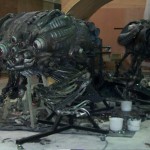
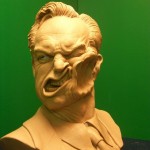
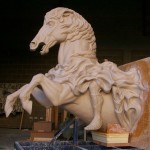
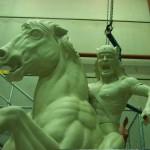
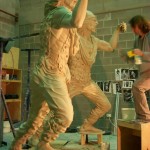
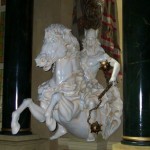
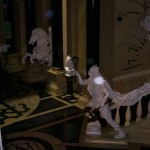
Ah, those were the days when we got to make really cool stuff. All gone down hill in the last 10 years or so.